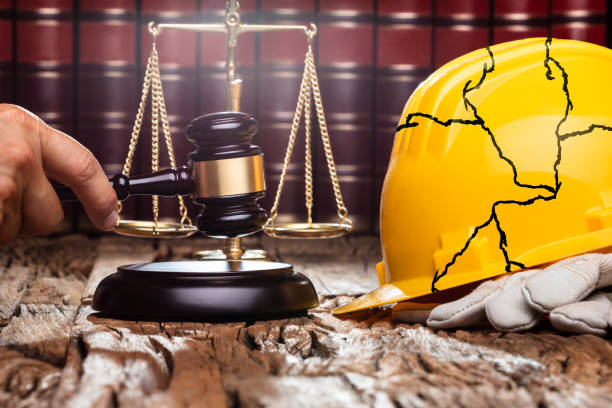Understanding Your Legal Options After a Construction Site Injury
Construction sites are among the most hazardous workplaces, and injuries are unfortunately common. If you or a loved one has been injured on a construction site, it’s important to understand your legal rights. Knowing your options can make a significant difference in the compensation you receive and your overall recovery. This guide explores your legal options after a construction site injury and how to take action.

Ready to connect with top legal professionals? Get immediate support— Call us at 877-550-8911.
Connect with Our Legal Team
Understanding Your Rights After a Construction Site Injury
After a construction site accident, you have several legal paths to consider. These typically include filing a
workers compensation claim, pursuing a
personal injury lawsuit, or filing a
third-party claim if other parties beyond your employer were involved.
The most common initial step is filing a workers compensation claim. This system is designed to provide medical benefits and wage replacement regardless of who was at fault. However, it often limits the total compensation you can receive.
In contrast, if a third party — such as a contractor, subcontractor, or equipment manufacturer — contributed to your injury, you may file a personal injury lawsuit. This legal option allows you to seek compensation beyond what workers comp offers, including damages for pain, suffering, and long-term disability.
For in-depth legal assistance, you can visit
Legal Case Review — a helpful resource that connects you with professionals who can guide you through your legal journey.
Types of Legal Claims Available to Injured Workers
Injured construction workers have multiple legal avenues to explore:
1. Workers Compensation Claims
Most employees injured on the job are covered under their employer’s workers compensation insurance. These claims cover medical treatment, lost wages, and rehabilitation. Workers comp is a no-fault system, meaning you don’t need to prove your employer was negligent.
However, there are limitations. You generally can’t sue your employer for more damages, even if unsafe conditions existed. That’s where other legal options come in.
2. Personal Injury Lawsuits
If your injury was caused by someone else’s negligence — a subcontractor, a property owner, or equipment manufacturer — you can file a personal injury lawsuit. These cases often allow for higher payouts than workers comp, especially when pain and suffering are considered.
3. Third-Party Liability Claims
These involve claims against individuals or companies not directly employing the injured worker but still involved in the accident. Examples include:
- Faulty scaffolding made by a negligent manufacturer
- Unsafe electrical work by another contractor
- Inadequate site supervision by a property owner
Third-party claims are valuable because they can supplement workers comp and provide more comprehensive compensation.
The Role of Workers Compensation in Construction Injuries
Workers compensation plays a vital role in supporting injured workers by offering:
- Medical treatment coverage
- Wage replacement
- Disability benefits
You are generally entitled to these benefits without needing to prove fault. However, if your injury results in long-term disability or significant pain and suffering, workers comp might not be enough. In such cases, exploring other legal avenues becomes essential.
According to the U.S. Department of Labor, workers compensation laws vary by state, so it’s crucial to understand your local regulations or consult with an attorney.
Filing a Personal Injury Lawsuit for Construction Accidents
Filing a personal injury lawsuit after a construction accident involves several steps:
- Seek Medical Attention: Your health and safety come first. Immediate medical care also establishes an official record of your injuries.
- Gather Evidence: Take photos of the accident site, your injuries, and any equipment involved.
- Document Everything: Keep a journal of your recovery and retain all medical records and bills.
- Contact a Lawyer: A construction injury lawyer can evaluate your case and determine whether you have grounds for a lawsuit.
Statutes of limitations vary by state, so don’t delay. Acting promptly ensures your case remains valid.
Identifying Third-Party Liability in Construction Site Injuries
To successfully claim third-party liability, you must prove:
- The third party owed a duty of care
- That duty was breached
- The breach caused your injury
- You suffered measurable damages
Examples of third parties might include:
- A crane manufacturer whose faulty equipment malfunctioned
- A subcontractor who failed to secure a scaffold
- A delivery company that created a hazard on-site
These claims are more complex than workers comp, but they can yield significantly more compensation.
Navigating the Legal Process After a Construction Injury
The legal journey following a construction injury can be overwhelming, especially when dealing with physical recovery. Here’s a simplified approach:
- Notify Your Employer: Report the injury as soon as possible.
- File a Workers Comp Claim: Get the process started and follow up with all necessary documentation.
- Consult an Attorney: Legal advice can clarify your rights and whether you should pursue further action.
- Investigate Liability: Your legal team will examine the accident’s details to identify any third-party involvement.
- File Suit if Needed: Depending on the outcome, you may proceed with a personal injury or third-party lawsuit.
This comprehensive approach ensures you’re not leaving potential compensation on the table.
Gathering Evidence to Support Your Legal Claim
Strong evidence is critical for proving your claim. Here’s what you should gather:
- Photos/Videos: Capture the accident scene, equipment, and injuries.
- Witness Statements: These can confirm your version of events and help establish liability.
- Medical Records: Keep all documentation of treatments, diagnoses, and related costs.
- Accident Reports: File and retain any reports submitted to your employer or OSHA.
You may also need safety inspection reports or product recalls to strengthen your third-party liability case.
 Consulting with a Legal Professional for Construction Injury Cases
Consulting with a Legal Professional for Construction Injury Cases
Speaking to an attorney familiar with construction site injury law is vital. They can:
- Determine what kind of claim to file
- Gather the right evidence
- Communicate with insurance companies and opposing lawyers
- Ensure all legal deadlines are met
By consulting a legal professional early, you maximize your chances of obtaining full compensation. You also gain peace of mind knowing that someone is advocating for your rights.
FAQs About Legal Options After a Construction Site Injury
Q1: Can I sue my employer for a construction site injury?
A: In most cases, no. Workers compensation prevents you from suing your employer, but you may sue third parties if they were negligent.
Q2: What is the difference between workers compensation and a personal injury lawsuit?
A: Workers comp covers medical bills and lost wages but doesn’t compensate for pain and suffering. A personal injury lawsuit can provide additional compensation.
Q3: How long do I have to file a lawsuit after a construction injury?
A: This depends on your state’s statute of limitations, which usually ranges from 1 to 3 years.
Q4: What should I do immediately after a construction site injury?
A: Seek medical care, report the incident, document the scene, and consult a legal professional.
Q5: Is workers compensation my only option?
A: No. If a third party contributed to your injury, you may have additional legal options, including personal injury or product liability claims.
Don’t wait to secure the legal representation you deserve. Visit Legal Case Review today for free quotes and tailored guidance, or call 877-550-8911 for immediate assistance.

 Consulting with a Legal Professional for Construction Injury Cases
Consulting with a Legal Professional for Construction Injury Cases


